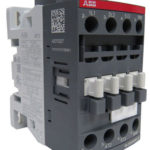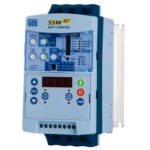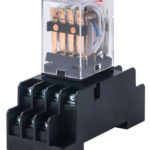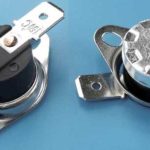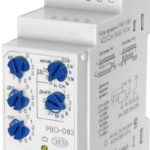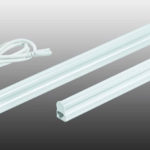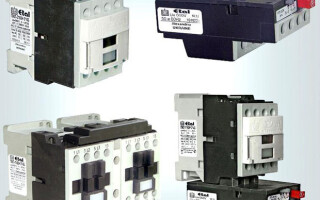Magnetic starter, or electromagnetic contactor, is a switching device that commutes high-power currents of DC and AC. Its role is to systematically turn on and off sources of electricity.
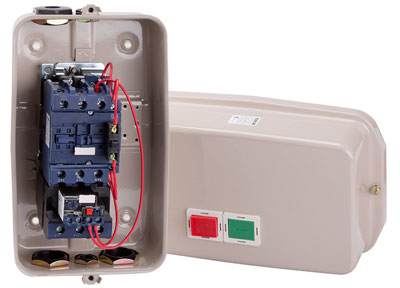
Contents
Purpose and construction
Magnetic starters are built into electrical circuits for remote starting, stopping and providing protection of electrical equipment, electric motors. Operation is based on the principle of electromagnetic induction.
The basis of design are thermal relay and contactor, combined in one device. Such a device is also capable of working in a three-phase network.
These devices are gradually replaced from the market by contactors. They do not differ from contactors in their design and technical characteristics, and it is only possible to distinguish them by their name.
They differ from each other by the supply voltage of the magnetic coil. It comes in 24, 36, 42, 110, 220, 380 W AC. Devices are available with a DC coil. Their use in the AC network is also possible, which requires a rectifier.
The construction of the starter is usually divided into upper and lower part. In the upper part there is a movable contact system, combined with an arc-quenching chamber. Also here is placed the moving part of the electromagnet, mechanically connected to the power contacts. All of this makes up the moving contact circuitry.
At the bottom is the coil, the other half of the solenoid and the return spring. The return spring returns the upper half to its original state when the coil is de-energized. This is how the contacts of the starter are broken.
Contactors come in:
- Normally closed. The contacts are closed and the power is supplied continuously, switching off occurs only after the starter has tripped.
- Normally open. The contacts are closed and power is supplied as long as the starter is running.
The second option is most common.
Principle of operation
The principle of operation of the magnetic starter is based on the phenomenon of electromagnetic induction. If no current flows through the coil, then there is no magnetic field in it. This causes the spring to mechanically repel the moving contacts. As soon as power is restored to the coil, magnetic currents are generated in the coil, compressing the spring and pulling the armature to the fixed part of the magnetic circuit.
Since the starter operates only by electromagnetic induction, contact opening occurs during power outages and when the mains voltage drops by more than 60% of its nominal value. When the voltage is restored, the contactor does not engage on its own. It will require the start button to be pressed to activate it.
If it is necessary to change the direction of rotation of the induction motor, reversing devices are used. Reversal is made by 2 contactors, which are activated one after the other. If the contactors are activated at one time, a short circuit occurs. To avoid such situations, a special interlock is included in the design.
Varieties and types
Starters, manufactured according to the Russian standards, are divided into 7 groups depending on the rated load. The zero group withstands the load of 6.3 A, the seventh group - 160 A.
This should be kept in mind when selecting magnetic starters.
Classification of foreign analogs may differ from that adopted in Russia.
It is necessary to be guided by the type of execution:
- Open. Suitable for installation in closed cabinets or places isolated from dust.
- Closed. Separately installed in dust-free rooms.
- Dust-proof. Can be installed anywhere, including outdoors. The main condition is to install a canopy to protect against sunlight and rain.
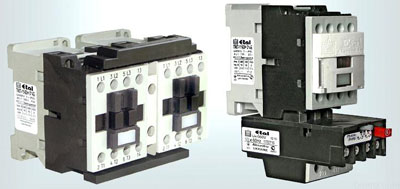
By type, the electromagnetic starter can be selected according to the following parameters:
- Standard versions, in which voltage is applied to the starter with a further pull of the core and activation of the contacts. In this case, depending on whether the starter is normally closed or normally open, the electrical equipment is switched on or off.
- Reversible modifications. Such a device is a reversing device with electromagnets. This design eliminates the simultaneous inclusion of 2 devices.
The marking of the magnetic starter encrypts its technical characteristics. The designation is placed on the body and may contain the following values:
- Series of the device.
- Rated current, the designation of which is inscribed with a range of values.
- The presence and design of the thermal relay. There are 7 degrees.
- Degree of protection and control buttons. There are a total of six positions.
- Availability of auxiliary contacts and their varieties.
- Conformity of mountings with standard mounting frames.
- Climate conformity.
- Layout options.
- Wear resistance.
There are several options for installing magnetic contactors in control systems, ranging from the simplest control of electric motors to installation with hold button contacts, or reversers.
220 volt wiring diagram
Any electrical wiring diagram contains 2 circuits, including for single-phase network. The first is the power circuit, through which the power is supplied. The second is the signal circuit. It is used to control the operation of the device.
The combined contactor, thermal relay and control buttons form a single device, which is marked as a magnetic starter in the diagram. It ensures proper functioning and safety of electric motors in various modes of operation.
The contacts for connecting the power supply to the device are located on top of the housing. They are designated A1 and A2. Thus, 220 V voltage is supplied to the 220 V coil. The order of the "zero" and "phase" connection does not matter.
On the lower part of the housing are several contacts marked L1, L2, L3. The power supply for the load is connected to them. Whether it is DC or AC does not matter, the main thing is the 220V limit. The voltage is taken from pins T1, T2, T3.
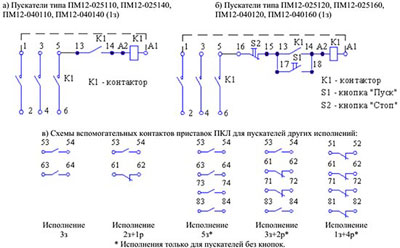
Wiring diagram for 380 V
The standard circuit is used when it is necessary to start the motor. It is controlled by means of push-buttons "Start" and "Stop". Instead of the motor, any load can be connected via magnetic starters.
In the case of three-phase supply, the power part includes:
- A three-pole circuit breaker.
- Three pairs of power contacts.
- A three-phase asynchronous electric motor.
The control circuit is powered from the first phase. It also includes the "Start" and "Stop" buttons, the coil and the auxiliary contact connected in parallel to the "Start" button.
When the start button is pressed, the first phase enters the coil. The starter is then actuated and all contacts are closed. The voltage flows to the lower power contacts and through them to the electric motor.
The circuit may vary depending on the voltage rating of the coil and the voltage of the mains supply used.
Connection via pushbutton post
A circuit that connects magnetic starters through a pushbutton post involves the use of an analog adapter. The contact blocks come in 3 or 4 outputs. When connecting, the direction of the cathode must be determined. Then the contacts are connected through a switch. A trigger of the two-channel type is used for this purpose.
If you connect a device with automatic switches, an electronic controller is used for them. The units in this case may be on the controller. Most often there are devices with wide-band connectors.
Related articles:
